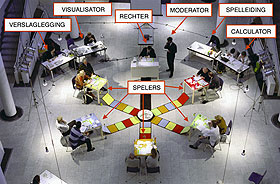
The methodology of The making of can best be applied at the stage when decisions about specific spatial issues still have to be made. The method involves all the parties concerned (residents, users, administrators and designers) on an equal basis from the very start of the planning and design process. This means that they are not solely involved according to their personal expertise, but also drawn beyond it, so that their horizons are widened and their grasp of the situation becomes more comprehensive. Bureau Venhuizen devised a game that confronts residents with the complexity of a design task, not by explaining it but by making them part of it. This gives them greater insight into the design process, so that they better understand and accept the results, and there is a greater willingness to contribute. Designers and policy-makers therefore gather more information, increasing the chances that a feasible plan is formulated which everyone is happy about.
The making of is essentially an abbreviated course in design. In the game, administrators and/or an area’s residents are invited to think up innovative plans for spatial planning issues. The game is highly realistic because it uses existing situations and future developments. In addition, the game’s players are informed about, consulted on and involved in future developments.

Participants must make proposals at a relatively quick tempo for specific tasks associated with a particular phenomenon. The teams must then raise objections to each other’s proposals. Objections can be negated by sound argumentation or by paying them off with lobbies (which can be won by throwing dice). If teams cannot reach a conclusion themselves, then it is down to the judge to reach a binding decision in favour of one team or the other. The team that is first to negate all the objections is the winner. Each session was reported in a text and with illustrations.
The making of goes further than simply endeavouring to reach consensus, instead hinging on the process of creation, precipitation and rooting of relevant concepts. This methodology makes the unavoidably complex task of spatial planning more accessible, while all the people involved are detached from their rigidly defined ideas about the forms in which they perceive quality and are made more aware of the constraints within which quality can be realized in their living environment.